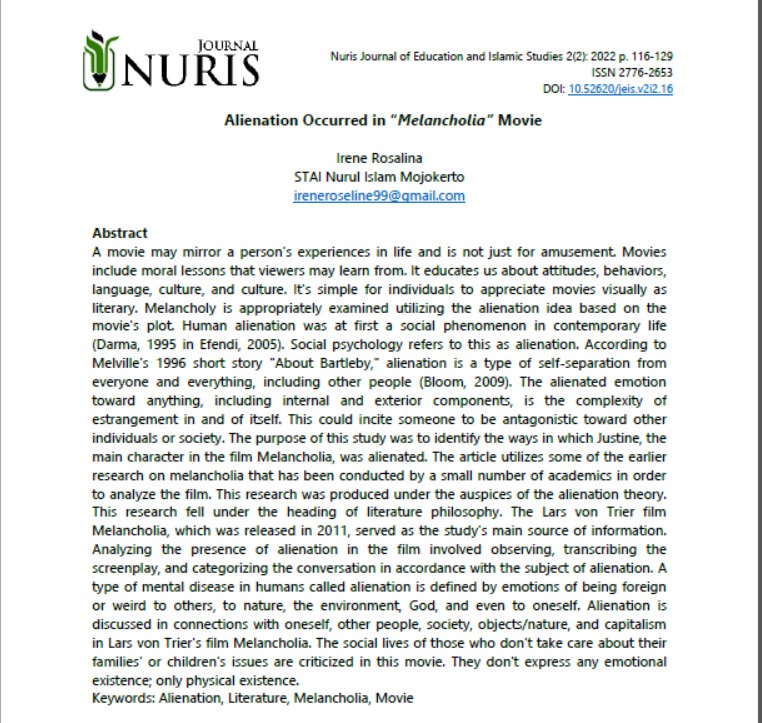Alienation Occurred in “Melancholia” Movie
Main Article Content
Abstract
A movie may mirror a person's experiences in life and is not just for amusement. Movies include moral lessons that viewers may learn from. It educates us about attitudes, behaviors, language, culture, and culture. It's simple for individuals to appreciate movies visually as literary. Melancholy is appropriately examined utilizing the alienation idea based on the movie's plot. Human alienation was at first a social phenomenon in contemporary life (Darma, 1995 in Efendi, 2005). Social psychology refers to this as alienation. According to Melville's 1996 short story "About Bartleby," alienation is a type of self-separation from everyone and everything, including other people (Bloom, 2009). The alienated emotion toward anything, including internal and exterior components, is the complexity of estrangement in and of itself. This could incite someone to be antagonistic toward other individuals or society. The purpose of this study was to identify the ways in which Justine, the main character in the film Melancholia, was alienated. The article utilizes some of the earlier research on melancholia that has been conducted by a small number of academics in order to analyze the film. This research was produced under the auspices of the alienation theory. This research fell under the heading of literature philosophy. The Lars von Trier film Melancholia, which was released in 2011, served as the study's main source of information. Analyzing the presence of alienation in the film involved observing, transcribing the screenplay, and categorizing the conversation in accordance with the subject of alienation. A type of mental disease in humans called alienation is defined by emotions of being foreign or weird to others, to nature, the environment, God, and even to oneself. Alienation is discussed in connections with oneself, other people, society, objects/nature, and capitalism in Lars von Trier's film Melancholia. The social lives of those who don't take care about their families' or children's issues are criticized in this movie. They don't express any emotional existence; only physical existence
Downloads
Metrics
Article Details

This work is licensed under a Creative Commons Attribution 4.0 International License.
License Terms
In submitting the manuscript to the journal, the authors certify that:
- They are authorized by their co-authors to enter into these arrangements.
- The work described has not been formally published before, except in the form of an abstract or as part of a published lecture, review, thesis, or overlay journal.
- That it is not under consideration for publication elsewhere,
- That its publication has been approved by all the author(s) and by the responsible authorities – tacitly or explicitly – of the institutes where the work has been carried out.
- They secure the right to reproduce any material that has already been published or copyrighted elsewhere.
- They agree to the following license and copyright agreement.
References
Barclay, Rachel. (2018). Alienation. Healthline.
https://www.healthline.com/health/alienation#symptoms
Studiobinder. (2021). High Angle Shot — Camera Angle Explained & Iconic Example.
Bloom, Harold. (2009). Alienation. Bloom’s Literary Criticism. New York.
Burkitt, Ian. (2019) Alienation and emotion: social relations and estrangement in contemporary capitalism. Emotions and Society. 1(1): 51-66.].
https://doi.org/10.1332/263168919X15580836411841
Cambridge University Press. (2021). Cambridge Dictionary. https://dictionary.cambridge.org/dictionary/english/melancholia
Christopher. (2021). Symbolism and Metaphor.
https://symbolismandmetaphor.com/cloud-symbolism/
Dubey, Arjun. (2013). Literature and Society. Journal Of Humanities And Social Science (Issue April), 9(6), 84. Applied Sciences &Humanities Madan Mohan Malaviya Engineering College, Gorakhpur U .P.India.
Doğan, S. (2008). Hegel and Marx on Alienation (Issue February). The Graduate School of Social Sciences of Middle East Technical University.
Efendi, A. (2005). Alienasi Tokoh Utama Dalam Novel Pol Karya Putu Wijaya. Litera, 4(1), 62–76. https://doi.org/10.21831/ltr.v4i01.4879
Gordon, Andrew. (2012). The Bride of Melancholia. PsyArt: An Online Journal for the Psychological Study of the Arts. Florida University. Florida.
Istikhomah. (2019). Alienasi Tokoh dalam Novel Tarian Dua Wajah Karya S . Prasetyo Utomo. Universitas Muhamadyah Malang.
Jackson, Kitty. (2018). Anselm Kiefer: Symbolism of the Forest. Artdependence Magazine.
Kaufman, S. M. (2021). Is Melancholia the greatest film about depression ever made? BBC. https://www.bbc.com/culture/article/20210512-is-melancholia-the-greatest-film-about-depression-ever-made
Kementerian Kesehatan Republik Indonesia. (2019). Situasi dan Pencegahan Bunuh Diri. In Pusat Data dan Informasi (pp. 1–10).
Kenny, A. (2007). Philosophy in the Modern World. Clarendon Press.
Marandika, D. F. (2018). Keterasingan Manusia menurut Karl Marx. Tsaqafah, 14(2), 229. https://doi.org/10.21111/tsaqafah.v14i2.2642
Mukhopadhyay, Roudro. (2020). Karl Marx's Theory of Alienation. 10.13140/RG.2.2.20186.47044.
MUBI. (n.d.). Beautiful, Interesting, Incredible Cinema. Retrieved November 16, 2021, from https://mubi.com/films/melancholia-2011
Raosaheb, M. Vijay. (2016). Existentialism: A Philosophic Stand Existence Over Essence. Shri Shivaji College.
Saleem, Abdul. Theme Of Alienation In Modern Literature, European Centre for Research Training and Development UK. 2(3), 67-76. ISSN 2055-0146
Wahyudi, T. (2017). Membaca Kemungkinan Film Sebagai Objek Penelitian Sastra. Parafrase, 17(02), 33–38. https://doi.org/https://doi.org/10.30996/parafrase.v17i2.1369
Wardhani, P. K. (2014). Keterasingan Tokoh Annah dalam Cerpen Orlamonde Karya Jean-Marie Gustave L Clezio. Universitas Indonesia.
Wenaus, Andrew. (2016). Mechanized Bodies, Human and Heavenly: Melancholia and Thinking Extinction. ESC. University of Western Ontario.

